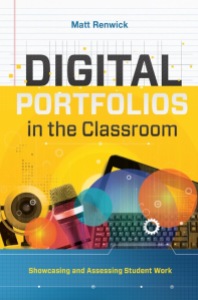At the risk of sounding like a know-it-all, I have wanted to point out a misconception that some educators have regarding digital portfolios and what is facilitated in classrooms.
This post comes from the idea that by merely publishing student work online for families and a wider audience to view, that students now have a digital portfolio. This isn’t accurate. Digital portfolios are defined as “a multimedia collection of student work that provides evidence of a student’s skills and knowledge” (Niguidula, 2010). This collection is not as simple as baseball cards or dead bugs. Student work within a digital portfolio has been carefully selected by a student and teacher and is accompanied with some sort of reflection, self-assessment, and goal setting. The online space in which a digital portfolio exists matters less than the learning acquired made evident by the content.
Here are three situations in which educators may think they are doing digital portfolios but actually are not.
- Social Media
If a teacher can get families to join a classroom Facebook page or follow a teacher-directed Twitter account, that is great. Teachers can model for students how to create a positive digital footprint and what it means to be a citizen in the 21st century. Pictures, video, and text that are shared in this way provide parents a window into the classroom. Most families also seem to like this way of staying connected with the classroom, especially if they already use that social media.
Why it’s not a digital portfolio: Social media is a popular way people communicate in today’s world. But it is not a useful tool for collecting and curating important artifacts of student work. Students need more permanent digital spaces to call their own when sharing their learning. In addition, social media might have unreliable security settings and can be susceptible to hackers.
- Home-to-School Digital Communication Tools
A number of applications that used to do one thing are now proclaiming that they also have a digital portfolio component. For example, Class Dojo, a behavior management app, allows teachers and students to share images and video with parents in addition to the points they accumulated for positive behaviors. Families can comment on what is posted and engage in a conversation about the work.
Why it’s not a digital portfolio: We are getting closer here, as each student has their own account for the teacher or student to post their work. The missing component is in how it’s used. Typically, the teacher is the one posting pictures and video for parents to see. Technology providers that advertise a digital portfolio function often do not see it as an assessment tool. There is little guidance provided for students or the teacher to reflect or self-assess on their work. The work and effort are usually owned by the teacher.
- Single Year Digital Lockers
In these situations, a teacher might actually be having students lead the digital portfolio process, including uploading their multimedia work and reflecting on it. The free version of digital portfolio tools such as FreshGrade or Seesaw is integrated into instruction. Over the course of the school year, families and the student can see how they have grown from fall to spring. This type of work can have a positive impact on learning.
Why it’s not a digital portfolio: Simply put, the student’s work disappears at the end of the school year, like cleaning out the lockers on the last day. There is no plan for maintaining past artifacts of learning from year to year. Students cannot look back on prior years to better understand their learning journey. Teachers cannot look at student work from the previous year to assess their needs for the current school year. There is no learning legacy for a student in these situations.
So what is a digital portfolio, for practical purposes? An online space that students maintain throughout their school career. It is directed by the student with guidance and support from their teachers. Students identify their best work to publish in a variety of areas that better represent who they are as a person, not just a pupil. True digital portfolios serve as a mosaic of their educational experience. It can even follow them beyond the K-12 years and serve as a professional portfolio for college applications or a job search.
Here are some ideas of what they could look like, year after year:
- Students post published pieces of writing in a Google Site or Weebly.
- Students share successes and challenges with families using paid versions of FreshGrade or Seesaw.
- Students document their learning and thinking over time with Edublogs or Kidblog.
- Students manage their personal learning projects with Epiphany Learning or Project Foundry.
Of course, all of the posted artifacts of student learning are accompanied with reflection, self-assessment, and goal setting for the future. Otherwise, it’s only sharing content. Nice, but not necessary for students’ education.

My new book, Digital Portfolios in the Classroom: Showcasing and Assessing Student Work, is now available for pre-order through ASCD! Click on the link below for more information and read the first chapter:
http://www.ascd.org/Publications/Books/Overview/Digital-Portfolios-in-the-Classroom.aspx